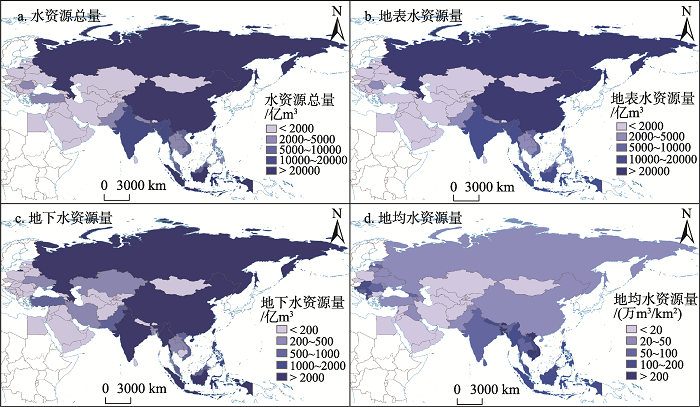

“一带一路”沿线国家水资源禀赋及开发利用分析
作者简介:杨艳昭(1977- ),女,辽宁朝阳人,博士,研究员,主要从事资源开发与区域发展研究。E-mail: yangyz@igsnrr.ac.cn
收稿日期: 2018-11-20
要求修回日期: 2019-04-20
网络出版日期: 2019-06-20
基金资助
中国科学院战略性先导科技专项(XDA20010201)
国家自然科学基金项目(41430861)
Water resources endowment and exploitation and utilization of countries along the Belt and Road
Received date: 2018-11-20
Request revised date: 2019-04-20
Online published: 2019-06-20
Copyright
水资源是基础性的战略资源,开展“一带一路”沿线国家水资源研究对于促进“一带一路”的科学建设具有重要意义。基于世界银行与联合国粮农组织水资源数据库,从水资源开发利用角度入手,分析“一带一路”沿线国家水资源自然禀赋、利用状况,在此基础上进一步分析水资源开发潜力。结果表明:(1)从水资源禀赋来看,“一带一路”沿线国家地表水、地下水和水资源总量均以俄罗斯、中国、东南亚和南亚地区相对较高,中亚、西亚等地区相对较低;人均水资源量则以中东欧、俄罗斯和东南亚地区较高,西亚、南亚地区较低;“一带一路”沿线国家外来水依赖率整体表现为跨境河流下游高,上游及海岛国家低。(2)就水资源利用而言,“一带一路”沿线国家用水量整体呈现“东多西少”的格局,人均用水量表现为“中亚最高,周边较低”的特点;用水结构亚洲国家多以农业用水为主,中东欧国家则多以工业用水为主。(3)水资源开发潜力分析发现,阿拉伯半岛地区各国水资源开发潜力很低,中东欧及东南亚地区水资源开发潜力很高。

关键词: “一带一路”沿线国家;; 水资源禀赋; 水资源利用; 水资源开发潜力
杨艳昭 , 封志明 , 孙通 , 汤峰 . “一带一路”沿线国家水资源禀赋及开发利用分析[J]. 自然资源学报, 2019 , 34(6) : 1146 -1156 . DOI: 10.31497/zrzyxb.20190602
Water resources is the basic strategic resource. It is of great significance to conduct research on water resources of countries along the Belt and Road for promoting the scientific construction of the Belt and Road. Based on the World Bank and the FAO Water Resources Databases, we started from the perspective of water exploitation and utilization, analyzed the natural endowment and utilization status of water resources of countries along the Belt and Road, and further explored the water resources exploitation potential status. The results showed that: (1) In terms of water endowment, the surface water, groundwater and total water resources were relatively high in Russia, China, Southeast Asia and South Asia, while they were relatively low in Central Asia and West Asia. The per capita water resource was relatively high in Central and Eastern Europe, Russia and Southeast Asia, while it was relatively low in West Asia and South Asia. The external water dependency rate was high in the downstream of transboundary rivers, while it was low in the upstream of transboundary rivers and island countries. (2) In terms of water utilization, the water consumption was higher in the east than in the west of the Belt and Road region, the per capita water consumption was the highest in Central Asia and it was low in the surrounding areas. In terms of water use structure, agricultural water was dominant in Asian countries, while industrial water was dominant in Central and Eastern Europe countries. (3) In terms of water resources exploitation potential, the exploitation potential of countries in the Arabian Peninsula was extremely low, and it was extremely high in Central and Eastern Europe and Southeast Asia.

Table 1 Countries along the Belt and Road表1 “一带一路”沿线国家 |
| 六大区域 | 主要国别 |
|---|---|
| 中蒙俄 | 中国、蒙古、俄罗斯 |
| 中亚 | 哈萨克斯坦、吉尔吉斯斯坦、塔吉克斯坦、乌兹别克斯坦、土库曼斯坦 |
| 东南亚 | 越南、老挝、柬埔寨、泰国、马来西亚、新加坡、印度尼西亚、文莱、菲律宾、缅甸、东帝汶 |
| 南亚 | 印度、巴基斯坦、孟加拉国、阿富汗、尼泊尔、不丹、斯里兰卡、马尔代夫 |
| 中东欧 | 波兰、捷克、斯洛伐克、匈牙利、斯洛文尼亚、克罗地亚、罗马尼亚、保加利亚、塞尔维亚、黑山、马其顿、波黑、阿尔巴尼亚、爱沙尼亚、立陶宛、拉脱维亚、乌克兰、白俄罗斯、摩尔多瓦 |
| 西亚/中东 | 土耳其、伊朗、叙利亚、伊拉克、阿联酋、沙特阿拉伯、卡塔尔、巴林、科威特、黎巴嫩、阿曼、也门、约旦、以色列、巴勒斯坦、亚美尼亚、格鲁吉亚、阿塞拜疆、埃及 |
Table 2 Evaluation classification for carrying index of water resources表2 水资源负载指数分级评价 |
| 级别 | C值 | 水资源利用程度及开发潜力 | 水资源进一步开发评价 |
|---|---|---|---|
| I | >10 | 很高,潜力很小 | 艰难,有条件时需要外流域调水 |
| II | 5~10 | 高,潜力小 | 开发条件很困难 |
| III | 2~5 | 中等,潜力较大 | 开发条件中等 |
| Ⅳ | 1~2 | 较低,潜力大 | 开发条件较容易 |
| Ⅴ | 0~1 | 低,潜力很大 | 兴建中小工程,开发容易 |
Fig. 1 Spatial distribution of water resources in the countries along the Belt and Road图1 “一带一路”沿线国家水资源量空间分布 |
Fig. 2 The per capita water resources of countries along the Belt and Road图2 “一带一路”沿线国家人均水资源量 |
Fig. 3 External water dependency rate of countries along the Belt and Road图3 “一带一路”沿线国家外来水依赖率 |
Fig. 4 Spatial distribution of water utilization of countries along the Belt and Road图4 “一带一路”沿线国家水资源利用量空间分布 |
Fig. 5 The water utilization structure of countries along the Belt and Road图5 “一带一路”沿线国家用水结构 |
Fig. 6 The residents' drinking water safety evaluation of countries along the Belt and Road图6 “一带一路”沿线国家居民饮用水安全国别评价 |
Fig. 7 The graded evaluation of water resources carrying index of countries along the Belt and Road图7 “一带一路”沿线国家水资源负载指数分级评价 |
The authors have declared that no competing interests exist.
| [1] |
[
|
| [2] |
[
|
| [3] |
|
| [4] |
|
| [5] |
[
|
| [6] |
[
|
| [7] |
[
|
| [8] |
[
|
| [9] |
[
|
| [10] |
|
| [11] |
[
|
| [12] |
[
|
| [13] |
|
| [14] |
[
|
| [15] |
[
|
| [16] |
[
|
| [17] |
[
|
| [18] |
[
|
| [19] |
[
|
| [20] |
[
|
| [21] |
[
|
| [22] |
[
|
| [23] |
[
|
| [24] |
[
|
| [25] |
[
|
| [26] |
[
|
| [27] |
[
|
| [28] |
[
|
| [29] |
[
|
/
| 〈 |
|
〉 |